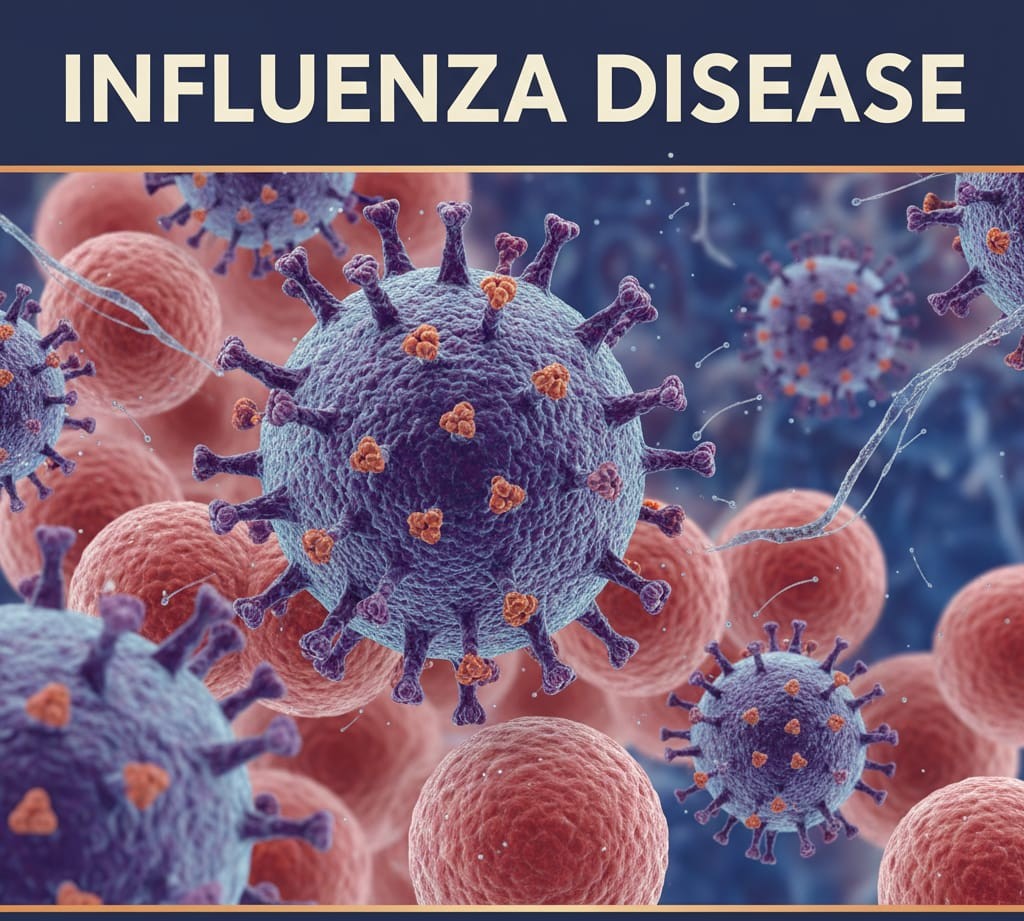Influenza: Causes, Symptoms, Treatment, and Prevention
Influenza, commonly called the flu, is a contagious respiratory illness caused by influenza viruses. It primarily affects the nose, throat, and lungs, leading to mild to severe illness. Every year, millions of people around the world suffer from influenza, and while most recover, it can sometimes lead to serious complications, especially in young children, older adults, pregnant women, and people with weakened immune systems.https://en.wikipedia.org/wiki/Influenza

What is Influenza?
Influenza is an acute viral infection that spreads easily from person to person through tiny droplets released when an infected person coughs, sneezes, or talks. Unlike some illnesses, influenza is not a year-round disease. It is seasonal, with outbreaks occurring mainly during winter in temperate regions.
Key Facts about Influenza:
- Caused by influenza viruses (types A, B, C, and D).
- Spreads via respiratory droplets and contaminated surfaces.
- Symptoms range from mild fever to life-threatening pneumonia.
- Annual vaccination is the most effective prevention method.
- Can lead to complications like bronchitis, sinus infections, and even death in severe cases.
Types of Influenza Viruses
The influenza virus is divided into four main types: A, B, C, and D.
- Influenza A
- Most common and most dangerous type.
- Found in humans and animals (birds, pigs).
- Responsible for major flu epidemics and pandemics (e.g., Spanish Flu 1918, Swine Flu 2009).
- Subtypes classified based on proteins Hemagglutinin (H) and Neuraminidase (N), such as H1N1, H3N2.
- Influenza B
- Only affects humans.
- Generally causes seasonal flu outbreaks.
- Less severe than Influenza A but still dangerous for children and elderly.
- Has two lineages: B/Yamagata and B/Victoria.
- Influenza C
- Causes mild respiratory illness.
- Rare and not linked to epidemics.
- Influenza D
- Primarily affects cattle.
- Does not infect humans but can indirectly affect public health through livestock.
Causes and Transmission of Influenza
The flu is caused by infection with influenza viruses. The virus enters the body through the nose, mouth, or eyes.
How Spreads:
- Person-to-person contact – inhaling droplets from coughs or sneezes.
- Touching contaminated surfaces – doorknobs, phones, or utensils, then touching nose or mouth.
- Close contact – being in crowded places like schools, offices, or public transport.
Risk Factors:
Certain groups are at higher risk of catching influenza or developing complications:
- Children under 5 (especially under 2 years).
- Adults above 65 years.
- Pregnant women.
- People with chronic conditions like asthma, diabetes, heart disease.
- People with weakened immune systems.
- Healthcare workers exposed to patients.
Symptoms
Flu symptoms usually appear 1–4 days after infection.
Common Symptoms:
- High fever (often sudden onset).
- Chills and body aches.
- Severe fatigue and weakness.
- Headache.
- Sore throat.
- Cough (usually dry and persistent).
- Runny or stuffy nose.
- Sweating.
- Nausea, vomiting, and diarrhea (more common in children).
Diagnosis of Influenza
Doctors usually diagnose influenza based on symptoms and history of recent exposure. In severe cases, tests are performed:
- Rapid Influenza Diagnostic Tests (RIDTs): Quick but less accurate.
- RT-PCR (Reverse Transcription Polymerase Chain Reaction): More accurate, detects specific virus type.
- Viral culture: Used mainly in research.
Treatment
Most cases of influenza resolve on their own with rest, fluids, and home care. However, in some cases, medical treatment is required.
- Home Remedies and Supportive Care
- Get plenty of rest.
- Drink warm fluids to stay hydrated.
- Use saline sprays or steam inhalation for congestion.
- Gargle with warm salt water for sore throat.
- Use over-the-counter medicines like acetaminophen or ibuprofen for fever and pain (avoid aspirin in children).
- Antiviral Medications
Antiviral drugs work best if taken within 48 hours of symptoms:
- Oseltamivir (Tamiflu)
- Zanamivir (Relenza)
- Peramivir (Rapivab)
- Baloxavir marboxil (Xofluza)
Complications
While most people recover in 1–2 weeks, flu can lead to severe complications, especially in vulnerable groups.
Common Complications:
- Sinus infections
- Ear infections
- Bronchitis
- Asthma flare-ups
- Serious Complications:
- Pneumonia (viral or bacterial)
- Sepsis
- Myocarditis (inflammation of the heart)
- Encephalitis (brain inflammation)
- Multiple organ failure in severe cases
- Each year, influenza causes hundreds of thousands of hospitalizations and deaths globally.
Prevention
- Vaccination
- Annual flu vaccine is the best protection.
- Recommended for everyone above 6 months of age.
- Helps prevent severe illness, hospitalization, and death.
- Vaccines are updated yearly to match circulating virus strains.
- Hygiene Practices
- Wash hands regularly with soap and water.
- Use alcohol-based hand sanitizers.
- Avoid touching your face with unwashed hands.
- Cover mouth and nose with tissue or elbow when coughing/sneezing.
- Avoid close contact with sick people.
- Healthy Lifestyle
- Eat a balanced diet rich in vitamins and minerals.
- Get enough sleep and manage stress.
- Exercise regularly to strengthen immunity.
Myths and Facts
- Myth: Flu is just a bad cold.
Fact: Flu is more severe and can lead to life-threatening complications. - Myth: Healthy people don’t need a flu vaccine.
Fact: Even healthy people can get severely sick or spread it to others. - Myth: You can get the flu from the vaccine.
Fact: Flu vaccines contain inactivated viruses and cannot cause flu. - Myth: Antibiotics can cure influenza.
Fact: Antibiotics treat bacterial infections, not viral infections like flu.
